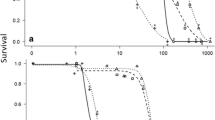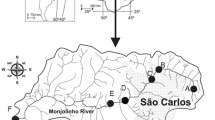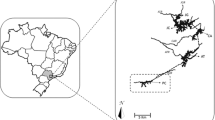Abstract
Purpose
Previous studies have shown that ivermectin, a widely used parasiticide, is very toxic to many non-target invertebrate species. In view of the strong binding of ivermectin to sediments and the scarcity of data on chronic toxicity to freshwater sediment invertebrates, chronic effects of the parasiticide on the midge Chironomus riparius and the oligochaete Lumbriculus variegatus were investigated.
Materials and methods
C. riparius and L. variegatus were exposed for up to 28 days to ivermectin-spiked artificial sediment. Nominal ivermectin concentrations were 3.1 to 50 µg/kg dry sediment in the Chironomus test and 50 to 5,000 µg/kg dry sediment in the Lumbriculus test. The evaluated endpoints were survival, growth, emergence ratio and development rate for C. riparius, and survival/reproduction and total biomass for L. variegatus.
Results and discussion
Ivermectin had a significant, concentration-dependent effect on larval survival and growth, emergence and development rate of C. riparius. With a lowest observed effect concentration (LOEC) of 6.3 µg/kg dry sediment, larval dry weight was the most sensitive endpoint. L. variegatus was considerably less sensitive to ivermectin than C. riparius. A LOEC of 500 µg/kg dry sediment was derived for effects on survival/reproduction and total biomass.
Conclusions
The results of the present study, especially the high toxicity of ivermectin to C. riparius, indicate that the potential impact of ivermectin on freshwater benthic invertebrates deserves further attention.



Similar content being viewed by others
References
Åkerblom N, Goedkoop W (2003) Stable isotopes and fatty acids reveal that Chironomus riparius feeds selectively on added food in standardized toxicity tests. Environ Toxicol Chem 22:1473–1480
Allen YT, Thain JE, Haworth S, Barry J (2007) Development and application of long-term sublethal whole sediment tests with Arenicola marina and Corophium volutator using ivermectin as test compound. Environ Pollut 146:92–99
Boxall ABA, Fogg LA, Baird DJ, Lewis C, Telfer TC, Kolpin D, Gravell A, Pemberton E, Boucard T (2006) Targeted monitoring study for veterinary medicines in the environment. Bristol, UK: Environment Agency. Science Report SC030183/SR
Brust K, Licht O, Hultsch V, Jungmann D, Nagel R (2001) Effects of Terbutryn on Aufwuchs and Lumbriculus variegatus in Artificial Indoor Streams. Environ Toxicol Chem 20:2000–2007
Campbell WC, Fisher MH, Stapley EO, Albers-Schonberg G, Jacob TA (1983) Ivermectin: a potent new antiparasitic agent. Science 221:823–828
Collier LM, Pinn EH (1998) An assessment of the acute impact of the sea lice treatment ivermectin on a benthic community. J Exp Mar Biol Ecol 230:131–147
Cully DF, Vassilatis DK, Liu KK, Paress PS, Van der Ploeg LHT, Schaeffer JM, Arena JP (1994) Cloning of an avermectin-sensitive glutamate-gated chloride channel from Caenorhabditis elegans. Nature 371:707–711
Davies IM, Rodger GK (2000) A review of the use of ivermectin as a treatment for sea lice [Lepeophtheirus salmonis (Køyer) and Caligus elongatus Nordmann] infestation in farmed Atlantic salmon (Salmo salar L.). Aquacult Res 31:869–883
Davies IM, Gillibrand PA, McHenery IG, Rae GH (1998) Environmental risk of ivermectin to sediment dwelling organisms. Aquaculture 163:29–46
De Haas EM, Wagner C, Koelmans AA, Kraak MHS, Admiraal W (2006) Habitat selection by chironomid larvae: fast growth requires fast food. J Animal Ecology 75:148–155
Ding J, Drewes CD, Hsu WH (2001) Behavioral effects of ivermectin in a freshwater oligochaete, Lumbriculus variegatus. Environ Toxicol Chem 20:1584–1590
Duce IR, Scott RH (1985) Actions of dihydroavermectin B1a on insect muscle. Brit J Pharmacol 85:395–401
Edwards CA, Atiyeh RM, Römbke J (2001) Environmental impact of avermectins. Rev Environ Contam Toxicol 171:111–137
Edwards R (1996) Salmon farmers win license to kill. New Scientist 151:4
Egeler P, Meller M, Schallnaß, HJ, Gilberg D (2005) Validation of a sediment toxicity test with the endobenthic aquatic oligochaete Lumbriculus variegatus by an international ring test. Technical Report, R&D No.: 202 67 429. Federal Environmental Agency (Umweltbundesamt), Berlin, Germany, pp 98
Elendt BP (1990) Selenium deficiency in crustacea: an ultrastructural approach to antennal damage in Daphnia magna Straus. Protoplasma 154:25–33
EMEA (2008) Revised guideline on environmental impact assessment for veterinary medicinal products in support of the VICH guidelines GL6 and GL38. European Medicines Agency. London, UK: Committee for Medicinal Products for Veterinary Use (CVMP), EMEA. EMEA/CVMP/ERA/418282/2005-Rev.1, pp 65
Garric J, Vollat B, Duis K, Péry ARR, Junker T, Ramil M, Fink G, Ternes TA (2007) Effects of the parasiticide ivermectin on the cladoceran Daphnia magna and the green alga Pseudokirchneriella subcapitata. Chemosphere 69:903–910
Grant A, Briggs AD (1998) Toxicity of ivermectin to estuarine and marine invertebrates. Mar Pollut Bull 36:540–541
Halley BA, Jacob TA, Lu AYH (1989) The environmental impact of the use of ivermectin: environmental effects and fate. Chemosphere 18:1543–1563
Hennessy DR, Alvinerie MR (2002) Pharmacokinetics of the macrocyclic lactones: conventional wisdom and new paradigms. In: Vercruysse J, Rew RS (eds) Macrocyclic lactones in antiparasitic therapy. CABI Publishing, New York, pp 97–124
Jensen J, Krogh PH, Sverdrup LE (2003) Effects of the antibacterial agents tiamulin, olanquindox and metronidazole and the anthelmintic ivermectin on the soil invertebrate species Folsomia fimetaria (Collembola) and Enchytraeus crypticus (Enchytraeidae). Chemosphere 50:437–443
Kövecses J, Marcogliese DJ (2005) Avermectins: potential environmental risks and impacts on freshwater ecosystems in Quebec. Scientific and technical report ST-233E. Environment Canada, Quebec Region, St. Lawrence Centre, Montreal
Krogh KA, Søeborg T, Brodin B, Halling-Sørensen B (2008a) Sorption and mobility of ivermectin in different soils. J Environ Qual 37:2202–2211
Krogh KA, Björklund E, Loeffler D, Fink G, Halling-Sørensen B, Ternes TA (2008b) Development of an analytical method to determine avermectins in water, sediments and soils using liquid chromatography-tandem mass spectrometry. J Chromatogr A 1211:60–69
Leppänen MT, Kukkonen JVK (1998) Relationship between reproduction, sediment type and feeding of Lumbriculus variegatus (Müller): implications for sediment toxicity testing. Environ Toxicol Chem 17:2196–2202
Liebig M, Meller M, Egeler P (2004) Sedimenttoxizitätstests mit aquatischen Oligochaeten—Einfluss verschiedener Futterquellen im künstlichen Sediment auf Reproduktion und Biomasse von Lumbriculus variegatus. Proceedings 5/2004: Statusseminar Sedimentkontakttests. March 24–25, 2004. BfG (Bundesanstalt für Gewässerkunde), Koblenz, Germany, pp 107–119
Liebig M, Alonso Fernandez Á, Blübaum-Gronau E, Boxall A, Brinke M, Carbonell G, Egeler P, Fenner K, Fernandez C, Fink G, Garric J, Halling-Sørensen B, Jensen J, Knacker T, Krogh KA, Küster A, Löffler D, Porcel Cots MÁ, Pope L, Prasse C, Römbke J, Rönnefahrt I, Schneider MK, Schweitzer N, Tarazona JV, Ternes TA, Traunspurger W, Wehrhan A, Duis K (accepted) Environmental risk assessment of ivermectin—a case study. Integrated Environmental Assessment and Management
Lopes C, Charles S, Vollat B, Garric J (2009) Toxicity of ivermectin on cladocerans: comparison of toxic effects on Daphnia and Ceriodaphnia species. Environ Toxicol Chem 28:2160–2166
Madsen M, Overgaard Nielsen B, Holter P, Pedersen OC, Brøchner Jespersen J, Vagn Jensen KM, Nansen P, Grønvold J (1990) Treating cattle with ivermectin: effects on the fauna and decomposition of dung pats. J Appl Ecol 27:1–15
OECD (1992) Guideline for Testing of Chemicals No. 203 “Fish, Acute Toxicity Test”. Organisation for Economic Co-Operation and Development, Paris, France, p 9
OECD (2004) OECD Guideline for the Testing of Chemicals No. 218: “Sediment-water chironomid toxicity test using spiked sediment” (adopted April 2004). Organisation for Economic Co-Operation and Development, Paris, France, p 21
OECD (2007) OECD Guideline for the Testing of Chemicals No. 225: Sediment-Water Lumbriculus Toxicity Test Using Spiked Sediment (adopted October 2007). Organisation for Economic Co-Operation and Development, Paris, France, p 31
Õmura S (2008) Ivermectin: 25 years and still going strong. Int J Antimicrob Ag 31:91–98
Prasse C, Löffler D, Ternes TA (2009) Environmental fate of the anthelmintic ivermectin in an aerobic sediment/water system. Chemosphere 77:1321–1325
Riedhammer C, Schwarz-Schulz B (2001) The newly proprosed EU risk assessment concept for the sediment compartment. J Soils Sediments 1(2):105–110
Römbke J, Floate KD, Jochmann R, Schäfer MA, Puniamoorthy N, Knäbe S, Lehmhus J, Rosenkranz B, Scheffczyk A, Schmidt T, Sharples A, Blanckenhorn WU (2009a) Lethal and sublethal toxic effects of a test chemical (ivermectin) on the yellow dung fly Scathophaga stercoraria based on a standardized international ring test. Environ Toxicol Chem 28:2117–2124
Römbke J, Krogh KA, Moser T, Scheffczyk A, Liebig M (2009b) Effects of the veterinary pharmaceutical ivermectin on soil invertebrates in laboratory tests. Arch Environ Contam Toxicol. doi:10.1007/s00244-009-9414-8
Sanderson H, Laird B, Pope L, Brain R, Wilson C, Johnson D, Bryning G, Peregrine AS, Boxall A, Solomon K (2007) Assessment of the environmental fate and effects of ivermectin in aquatic mesocosms. Aquat Toxicol 85:229–240
Schweitzer N, Fink G, Ternes TA, Duis K (2009) Effects of ivermectin-spiked cattle dung on a water-sediment system with the aquatic invertebrates Daphnia magna and Chironomus riparius. Aquatic Toxicology. doi:10.1016/j.aquatox.2009.12.017
Shoop W, Soll M (2002) Ivermectin, abamectin and eprinomectin. In: Vercruysse J, Rew RS (eds) Macrocyclic lactones in antiparasitic therapy. CABI Publishing, New York, pp 1–29
Shoop WL, Mrozik H, Fisher MH (1995) Structure and activity of avermectins and milbemycins in animal health. Vet Parasitol 59:139–156
Steel JW, Wardhaugh KG (2002) Ecological impact of macrocyclic lactones on dung fauna. In: Vercruysse J, Rew RS (eds) Macrocyclic Lactones in Antiparasitic Therapy. CABI Publishing, New York, pp 457–480
Strong L, Brown TA (1987) Avermectins in insect control and biology: a review. Bull Entomol Res 77:357–389
Thain JE, Davies IM, Rae GH, Allen YT (1997) Acute toxicity of ivermectin to the lugworm Arenicola marina. Aquaculture 159:47–52
VICH (2004) Environmental impact assessment for veterinary medicinal products phase II guidance. VICH GL 38 (Ecotoxicity Phase II). International Cooperation on Harmonisation of Technical Requirements for Registration of Veterinary Medicinal Products, London, UK
Acknowledgements
The present study was part of the project ‘Environmental risk assessment of pharmaceuticals’ (ERAPharm) that was funded within the 6th framework programme of the European Commission (project number SSPI-CT-2003-511135). The authors wish to thank Marika Goth and José Pedro Ferreira (ECT Oekotoxikologie GmbH) for technical assistance during test performance. This article is dedicated to Hans-Joachim Schallnaß (ECT Oekotoxikologie GmbH).
Author information
Authors and Affiliations
Corresponding author
Additional information
Responsible editor: Wolfgang Ahlf
Rights and permissions
About this article
Cite this article
Egeler, P., Gilberg, D., Fink, G. et al. Chronic toxicity of ivermectin to the benthic invertebrates Chironomus riparius and Lumbriculus variegatus . J Soils Sediments 10, 368–376 (2010). https://doi.org/10.1007/s11368-010-0197-3
Received:
Accepted:
Published:
Issue Date:
DOI: https://doi.org/10.1007/s11368-010-0197-3




